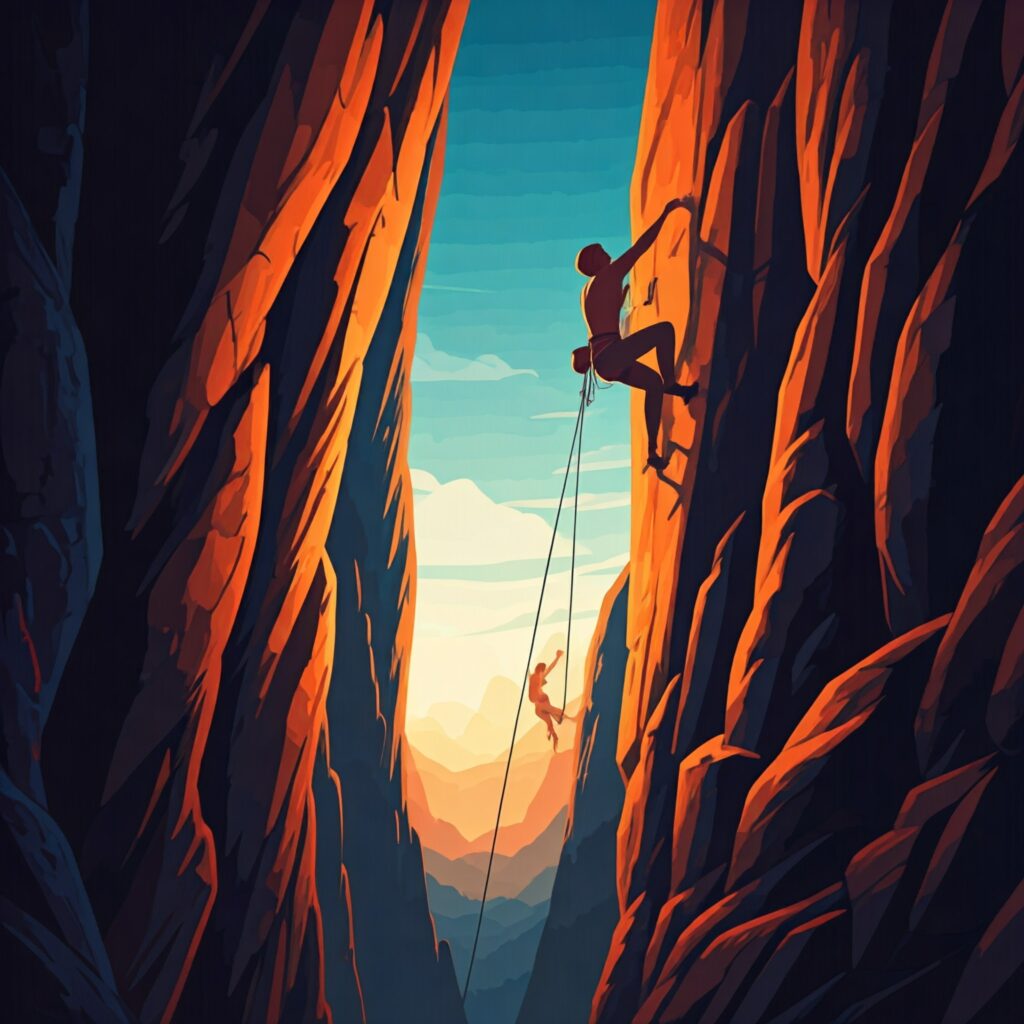HAPPY FALL Y'ALL! --- Check out our HOLIDAY gift ideas!
Embark on an Unforgettable Climbing Adventure: A Comprehensive Guide to Camping & Hiking for Rock Climbing Enthusiasts

The siren call of towering cliffs and challenging routes beckons camping & hiking enthusiasts to embark on thrilling climbing adventures. But the world of rock climbing, nestled within the broader outdoor context, can appear intimidating to those unfamiliar with its nuances. This blog post aims to equip you with the knowledge and resources to transform your camping & hiking trips into unforgettable climbing adventures, addressing common concerns and offering practical tips for a safe, enjoyable, and rewarding experience.
Table of Contents
Conquering the Fear of Heights: A Step-by-Step Approach
Fear of heights, also known as acrophobia, is a common human experience, even among seasoned climbers. It’s crucial to remember that this fear is a natural response and can be managed effectively with the right techniques and mindset.
- Start Small and Build Confidence: Begin your climbing adventure at an indoor climbing gym or on shorter, less exposed outdoor routes. These controlled environments provide a safe space to develop your skills and acclimate to heights gradually. As your confidence grows, progressively challenge yourself with higher and more technical climbs.
- Master Proper Climbing Techniques and Safety Procedures: Understanding and implementing proper climbing techniques and safety protocols is paramount for reducing anxiety and instilling a sense of control. Enroll in a beginner’s climbing course or seek guidance from experienced climbers to learn essential skills such as belaying, rappelling, and knot tying. Knowing you have the expertise and equipment to climb safely can significantly diminish fear and empower you to push your limits.
- Harness the Power of Positive Self-Talk: Negative thoughts can spiral quickly, amplifying fear and undermining your confidence. Combat these mental roadblocks by replacing them with positive affirmations. Remind yourself of your strengths, previous successes, and the sheer joy of overcoming challenges. Focus on the present moment, the rhythm of your breath, and the precise movements of your body as you ascend the rock face.
- Embrace Breathing Exercises for Calm and Focus: Deep, controlled breathing techniques, such as diaphragmatic breathing or box breathing, can effectively calm nerves and mitigate physical symptoms of anxiety. Practice these exercises regularly, both on and off the climbing wall, to develop a sense of calm and focus that you can access when facing challenging climbs or moments of fear.
- Forge a Strong Partnership Based on Trust and Communication: If you’re climbing with a partner, open and honest communication about your fears is essential for building a strong and supportive relationship. Express your concerns, listen attentively to your partner’s guidance, and trust in their ability to keep you safe. A solid partnership rooted in trust and clear communication is fundamental for a positive and enriching climbing adventure.
Navigating the Weather: Preparing for the Unpredictable
Mountain weather is renowned for its fickleness, capable of swift and dramatic shifts that can impact your safety and enjoyment. Thorough preparation is essential for mitigating weather-related risks and ensuring a successful climbing adventure.
- Consult Multiple Weather Sources for Accurate Forecasts: Before embarking on your climbing adventure, diligently check weather forecasts from multiple sources, including mountain-specific weather websites or apps. Pay close attention to potential changes in temperature, wind speed, precipitation, and visibility, adjusting your plans accordingly.
- Pack for a Range of Conditions with Layered Clothing: Mountain weather can fluctuate drastically, so packing a variety of clothing layers is crucial. Include warm base layers to wick away moisture, insulating mid-layers for warmth, and waterproof and windproof outer shells to protect against the elements. Don’t forget essentials like hats, gloves, and sunglasses to shield yourself from the sun and cold.
- Carry an Emergency Shelter for Unexpected Situations: A lightweight, compact emergency shelter can provide vital protection in the event of sudden storms, unexpected delays, or injuries that require shelter while awaiting rescue. Choose a shelter that is easy to set up and can accommodate your climbing group comfortably.
- Ensure Reliable Communication with a Charged Device: A fully charged cell phone or satellite communication device is an indispensable safety tool in the event of an emergency. Check network coverage in your climbing area and consider renting or purchasing a satellite phone if cell service is unreliable. Always inform someone of your climbing plans, including your route, estimated return time, and emergency contact information.
- Prioritize Safety and Turn Back When Necessary: The mountains will always be there, awaiting your next climbing adventure. If weather conditions deteriorate, putting your safety at risk, don’t hesitate to turn back. A wise climber knows when to retreat and live to climb another day.
Selecting Essential Gear: Choosing the Right Tools for a Successful Climb
Investing in high-quality climbing gear is an investment in your safety and performance. The right equipment can enhance your climbing adventure, making it more comfortable, efficient, and enjoyable.
- Climbing Shoes: Climbing shoes are designed to fit snugly, providing support, sensitivity, and friction for precise footwork on rock. Choose shoes that fit your foot shape and climbing style, and consider renting shoes initially to find the best fit before purchasing.
- Harness: A comfortable, well-fitting harness is crucial for securing you to the rope and belay system. Harnesses distribute weight evenly, preventing discomfort and injury during falls or prolonged hanging.
- Rope: Climbing ropes are dynamic, meaning they stretch to absorb the force of a fall. Choose a rope specifically designed for climbing, ensuring it’s the appropriate length and diameter for the type of climbing you’ll be doing.
- Belay Device: A belay device is a mechanical friction brake used to control the rope and protect the climber in case of a fall. There are various types of belay devices, each with its pros and cons. Seek guidance from experienced climbers or instructors to select the device best suited for your needs.
- Carabiners: Carabiners are metal loops with spring-loaded gates used to connect various pieces of gear. They are essential for attaching the rope to the harness, clipping into protection points, and creating anchors.
- Helmet: A climbing helmet is non-negotiable for protecting your head from falling rocks or debris and in case of a fall. Choose a helmet that fits comfortably and meets safety standards.
Mastering Navigation and Route Finding: Staying on Track during Your Climbing Adventure
Getting lost in the mountains can be a disorienting and potentially dangerous experience. Developing solid navigation skills is paramount for staying on course and ensuring a safe return.
- Become Proficient with Map and Compass Navigation: Topographic maps and compasses are essential tools for accurate navigation in the mountains. Learn to read topographic maps, interpret contour lines, and use a compass to orient yourself and pinpoint your location. Practice these skills in familiar terrain before venturing into more challenging areas.
- Utilize a GPS Device as a Backup Tool: GPS devices can be helpful for navigation, especially in unfamiliar or complex terrain. However, rely on your map and compass skills as your primary navigation methods, using the GPS as a backup in case of emergencies or challenging route-finding situations.
- Pay Attention to Trail Markers and Signs: Be vigilant in observing trail markers, cairns (piles of rocks used as trail markers), and other signs that indicate the correct route. Be especially mindful at trail junctions, carefully studying your map to avoid taking a wrong turn.
- Consult Route Descriptions and Guidebooks: Guidebooks, online resources, and climbing communities often provide detailed route descriptions, including landmarks, difficulty ratings, potential hazards, and gear recommendations. Familiarize yourself with the route you plan to climb before setting out.
- Seek Local Knowledge from Experienced Climbers or Park Rangers: If possible, connect with local climbers or park rangers to gather insights on route conditions, recent changes, and potential challenges specific to your climbing area. Their firsthand experience can be invaluable for planning a safe and successful climb.
Planning Camping & Hiking Logistics for a Seamless Climbing Adventure
Combining rock climbing with camping & hiking requires careful logistical planning to ensure a comfortable, efficient, and enjoyable experience.
- Prioritize Lightweight and Packable Gear: Choosing lightweight and packable gear is crucial for minimizing the weight and bulk you’ll be carrying on your hike to your climbing destination. Look for gear specifically designed for backpacking or mountaineering, which prioritizes durability and functionality while minimizing weight.
- Research Campsites Strategically for Proximity and Amenities: Research campsites near your chosen climbing objectives, considering factors such as proximity to water sources, shelter from wind and sun, bear-proof storage options, and toilet facilities. Reserve campsites in advance, especially during peak climbing seasons.
- Pack Sufficient Food and Water for Increased Energy Demands: Climbing is physically demanding, requiring ample calorie intake and hydration. Pack enough food and water for your entire trip, considering the increased energy expenditure and the potential for unexpected delays. Choose lightweight, calorie-dense foods that provide sustained energy, such as nuts, dried fruit, energy bars, and trail mix.
- Practice Leave No Trace Principles for Responsible Recreation: Embrace the principles of Leave No Trace, packing out all trash, properly disposing of human waste, minimizing campfire impacts, and respecting wildlife and other visitors. Leave the climbing area as pristine as you find it.
- Invest in Camp Comfort for rest: A comfortable sleeping pad and sleeping bag suitable for the expected temperatures are essential for a good night’s rest after a day of climbing. A lightweight camp chair can provide a welcome respite for your legs and back after a long hike or climb.
Rock Climbing Trivia: Did You Know?
- The highest mountain in the world, Mount Everest, stands at 8,848.86 meters (29,031.7 feet) above sea level. [This information is not from the provided sources and may need to be independently verified]
Rock climbing, when integrated thoughtfully with camping & hiking trips, offers a unique and exhilarating way to experience the outdoors. By addressing common concerns, preparing diligently, and approaching challenges with a positive and adaptable mindset, you can transform your camping & hiking excursions into unforgettable climbing adventures that will inspire and challenge you for years to come.




